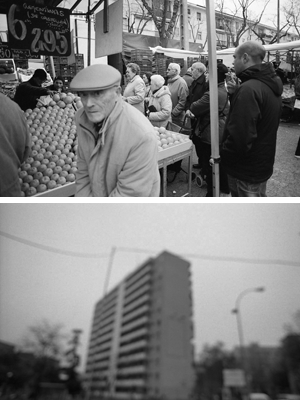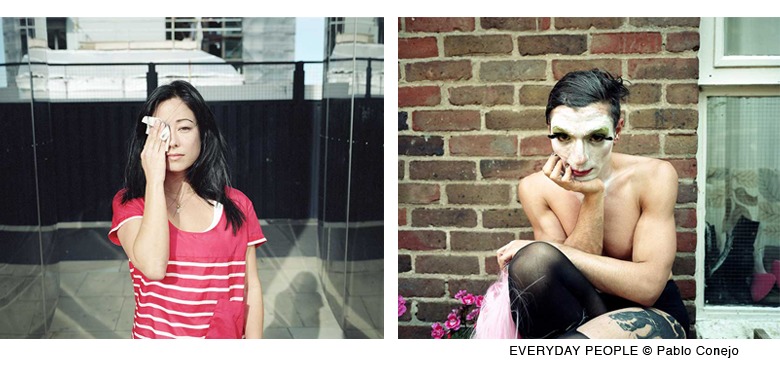Originally from Madrid, photographer Pablo Conejo has lived in London since 2004. His work has been exhibited in London and published on the blog of prestigious magazine TIME: LightBox. His earlier work focused mainly on urban landscapes and architecture, but in 2013 he surprised us with his project ‘Everyday People’. He took on the challenge of creating a portrait of anybody who wanted to be photographed, posting an advert for subjects on a popular classified ads website in London. One of the portraits from this project has been selected for the KLPA13 Exhibition in the Galeri Petronas in Kuala Lumpur’s Twin Towers.
Originally from Madrid, photographer Pablo Conejo has lived in London since 2004. His work has been exhibited in London and published on the blog of prestigious magazine TIME: LightBox.
His earlier work focused mainly on urban landscapes and architecture, but in 2013 he surprised us with his project ‘Everyday People’. He took on the challenge of creating a portrait of anybody who wanted to be photographed, posting an advert for subjects on a popular classified ads website in London. One of the portraits from this project has been selected for the KLPA13 Exhibition in the Galeri Petronas in Kuala Lumpur’s Twin Towers.
In his recently updated online portfolio, you can see eight of his pictures, all very different but sharing one thing in common: loyalty to the reality of what is being photographed. Nothing is modified. His camera is sincere, showing us the reality of cities and their inhabitants just as they are, from a point of view that is, as the artist himself recognises, almost anthropological.

© Pablo Conejo
1. Madrid, Estonia, Manila, China, Japan… looking at the list of places you have photographed gives the impression that you’re beating a trail to the East. Is there something behind that? Well, to be honest, I never specifically set out to do that, it’s pure chance, but you’ve just given me an idea; perhaps I should continue that route until I get right back round to the point I started out from…
Ther have been different reasons behind every trip. I’m really attracted by the big Asian cities, and the fact of being completely alien to their cultures makes them even more attractive. But I’d never say no to any location, I think all places are interesting and there to be explored.
2. Tell us a bit about your ‘Everyday People’ project. How did the idea come about? Any stories you’d like to share? The idea came about when I was using the website Gumtree. I started to sniff around the site and the range of different things you can use it for, from finding work or selling a lamp to looking for a date or getting in touch with a stranger who had helped you after an accident. The variety of people in London has always surprised me, but it isn’t easy to get close to people you find interesting. So, without giving it much thought, I tried putting up an advert offering to photograph absolutely anyone who responded. Surprisingly, a lot of people replied to the first advert, and in fact didn’t all just offer to be photographed – some of them really open up to you and they let you in to quite personal situations. The essence of the project is that the individuals should be the ones to decide the situation they want to be portrayed in. It is in itself a challenge that the sittings tend to be very short, without us meeting each other beforehand, so sometimes there is chemistry, and sometimes there isn’t, sometimes they have a very clear idea of what they want and sometimes they don’t. I’m interested in the anthropological aspect of the project and also the voyeuristic side of it, finding out who is behind the responses to the ad, what sort of person are they, what sort of life do they lead?
3. The contrasts you show and the absence of colour in the images in your ‘Madrid’ series seem to dramatise the current situation in Spain and the economic crisis. Has nearly a decade living abroad helped you to be more critical when it comes to portraying your city? What was the starting point for this work? The last few times that I’ve been to Madrid, I’ve had the feeling that it’s stuck in time. I’m not talking about politics or the crisis, it’s a personal perception and a purely aesthetic one. Perhaps the fact of not living there day to day has given me a different perspective, or perhaps I’m mixing that with nostalgia, but when I walk through the streets it seems to me that it could, in 2013, still be exactly the same as it was in the 70s. I’m not saying that pejoratively – in fact, that’s something that I love about the city. It’s this perception that steers me towards black and white: I find monochrome more inspiring than colour.
Yes, living abroad has changed my perception of my own city. I don’t know whether or not it has made me more critical, but of course I see it with different eyes. When you’re in one place you tend to keep to the same social circles and routines and sometimes you explore your own city less than one you are new to. Now, when I go back I like to go to the places I never visited when I lived there, explore the city better, and re-interpret it. From the start, this series had no stated aims – I’m not looking for the crisis, or to document what is happening. It’s my personal stroll through Madrid, my perceptions, the city’s idiosyncrasies… It has neither beginning nor end: I’ll keep adding photos of subsequent visits, like a sort of diary.
“London is a hard drug, it gets you hooked and you don’t know how to quit it. It makes you suffer, it burns, it punishes you, exhausts you, squeezes you; it’s extreme. But it’s extreme in all senses, both good and bad.”
4. What’s your experience of life as a Londoner? From your point of view, is it easier to break through as a photographer here or in Spain? My experience as a Londoner… it’s been a bit of everything. London is a hard drug, it gets you hooked and you don’t know how to quit it. It makes you suffer, it burns, it punishes you, exhausts you, squeezes you: it’s extreme. But it’s extreme in all senses, both good and bad. For me, it keeps me alive, it’s impossible to get bored here… tired, yes, but bored, that’s difficult.
Whether it’s easier to break through as a photographer here or there… I don’t know. I believe that right now it doesn’t matter much where you are, the internet opens doors. But I’m not the best person to answer that since I have never tried to make a living out of photography. For me it’s a passion, and I combine it with other activities. What I do find in London is that there’s lots of cultural activity going on, more than in Spain and in as much as this is stimulating, then yes it does influence me.
5. Finally, and as a contributor to our magazine, we’d like to thank you for collaborating, and ask for a bit of advice from the point of view of a Brit Es*. I’d like to thank you too… Some advice? Well that you pursue this idea with great passion and hunger.
(* The concept ‘Brit Es’ is a way of defining a cultural project, movement or trend, or the person behind these things, that appears in the UK, is Spanish in character or origin but is in turn influenced by or suffused with British culture. )
We’ll leave you with Conejo’s new website, so you can get to know the work of Pablo Conejo a little better: www.pabloconejo.com
TIME: LightBox: lightbox.time.com/2012/04/02/replicas/#1 KLPA13
Exhibition in the Galeri Petronas in Kuala Lumpur’s Twin Towers: klphotoawards.blogspot.co.uk/2013/04/pablo-conejo-uk-klpa13-finalist.html
[su_note note_color=”#eaeae9″]Translated by Sam Burne James[/su_note]

